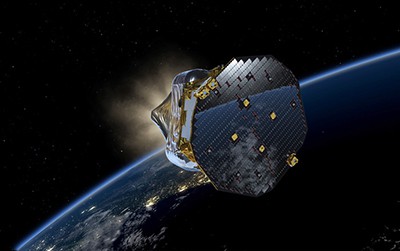
The European Space Agency (ESA) has launched a concept mission to test the technology required for a space-based gravitational-wave observatory. Sent into space today at 04:15 GMT (05:15 CET) on a Vega rocket from Kourou in French Guiana, LISA Pathfinder will now make its way to “Lagrange Point 1”. Lying about 1.5 million kilometres from Earth in the direction of the Sun, this point in space provides a very stable environment to control the precision of the instruments on the satellite. The launch of LISA Pathfinder marks the 100th anniversary of Albert Einstein’s general theory of relativity.
Gravitational waves are distortions of space–time that occur when massive bodies, such as black holes, are accelerated. Ground-based detectors – such as the Advanced Laser Interferometer Gravitational-Wave Observatory located in Hanford, Washington and Livingston, Louisiana – are already trying to identify high-frequency gravitational waves in the 100–500 Hz range, but they have so far turned up empty-handed. As for finding lower-frequency waves, these are inaccessible on Earth because ground-based interferometers would be required to have impossibly long arms. A space-based mission, however, could pick up gravitational-waves with frequencies between 10–4–10–1 Hz from, for example, the coalescence of supermassive black holes.
Trillionth of a metre
LISA Pathfinder will use two 2 kg test masses made of gold and platinum that will float freely inside the craft and be separated by 38 cm. It will have a 20 × 20 cm optical bench – containing 22 mirrors and beamsplitters – to measure with a laser the deviations in their movements to an accuracy of a trillionth of a metre.
LISA Pathfinder will not be able to detect gravitational waves directly because their impact is so tiny that the test masses would need to be millions of kilometres apart. The experiment will, however, demonstrate that the two independent masses can be monitored as they free fall through space. The goal is to minimize external and internal disturbances to the point where the position of the test masses would be more stable than the expected change caused by a passing gravitational wave – a change in distance equal to much less than the size of an atom.
We will learn a huge amount about operating such instrumentation in space Martin Hewitson, Max Planck Institute for Gravitational Physics
“As well as testing the technologies needed for future space-based observatories, LISA Pathfinder will also allow us to characterize most of the sources of disturbance that we expect to face with such an instrument, allowing us to optimize the design of any future observatory,” says Martin Hewitson of the Max Planck Institute for Gravitational Physics in Hannover, Germany, which is a leading partner in the mission. “We will learn a huge amount about operating such instrumentation in space, so that we expect to have demonstrated the ability to place test masses in free fall at the level needed to routinely observe gravitational waves in a full-scale space-based observatory.”
If the mission succeeds, it could pave the way for a future space-based gravitational-wave observatory. One such proposal is eLISA, which would measure gravitational waves using laser beams bounced off test masses inside three identical spacecraft placed at the vertices of a virtual equilateral triangle with sides a million kilometres long. A passing wave would change the distance between the masses by just a few trillionths of a metre, causing the beams’ interference pattern to vary. Such a mission is unlikely to be launched before the early 2030s at the earliest.
Exciting time
“It is an exciting time in gravitational-wave astronomy. The flight of LISA Pathfinder will be a major milestone in the endeavour to observe gravitational waves from space by testing much of the critical technology needed to build a full-scale observatory, such as eLISA,” adds Hewitson. “The team has waited for this moment for a long time, and we can’t wait to begin the experimental campaign and get our hands on the data.”
Physicist Monica Colpi of the University of Milano Bicocca, Italy, who is also a member of the eLISA consortium board, says the launch of LISA Pathfinder will “mark the beginning of a new era for astrophysics, cosmology and fundamental physics”. “The gravitational-wave sky is clearly an unexplored frontier, and for this reason it holds great potential for discovery and, equally important, the promise for understanding one of the most mysterious interactions of nature: gravity,” she adds.
The main scientific mission for LISA Pathfinder will begin on 1 March 2016 and last for at least six months.
- Nergis Mavalvala of the Massachusetts Institute of Technology explains how we can detect gravitational waves in the 100 Second Science video below



